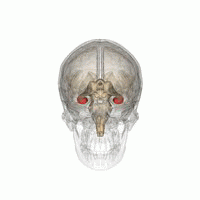
The passive avoidance task ameliorate the toxic effects of bisphenol A on dopamine D1 receptor density in hippocampus, amygdala, and cerebellum of male rats
Sign Up to like & getrecommendations! Published in 2023 at "Brain and Behavior"
DOI: 10.1002/brb3.2942
Abstract: Dopamine D1 receptor seems to play a role in mediating plasticity. Therefore, the present study aimed to investigate the effects of passive avoidance tasks postexposed to BPA on dopamine D1 receptor density in the hippocampus,… read more here.
Keywords: dopamine receptor; passive avoidance; density hippocampus; receptor ... See more keywords

Sex-dependent effects of chronic fluoxetine exposure during adolescence on passive avoidance memory, nociception, and prefrontal brain-derived neurotrophic factor mRNA expression
Sign Up to like & getrecommendations! Published in 2020 at "Brain Research Bulletin"
DOI: 10.1016/j.brainresbull.2020.06.009
Abstract: Fluoxetine, a common antidepressant drug, is widely used for mental disorders therapy in adolescents. Previous animal experiments have indicated that exposure to fluoxetine during adolescence leads to persistent behavioral changes and neuroplasticity in the hippocampal… read more here.
Keywords: passive avoidance; chronic fluoxetine; fluoxetine; mrna expression ... See more keywords

Chronic NaHS treatment improves spatial and passive avoidance learning and memory and anxiety-like behavior and decreases oxidative stress in rats fed with a high-fat diet
Sign Up to like & getrecommendations! Published in 2020 at "Brain Research Bulletin"
DOI: 10.1016/j.brainresbull.2020.09.007
Abstract: Cognitive function is impaired by increased consumption of a high-fat diet (HFD). Also, HFD consumption can alter hydrogen sulfide (H2S) metabolism. H2S is an important signaling molecule with antioxidant effects that regulates multiple functions in… read more here.
Keywords: passive avoidance; like behavior; anxiety like; memory ... See more keywords

Attenuating effect of paroxetine on memory impairment following cerebral ischemia-reperfusion injury in rat: the involvement of BDNF and antioxidant capacity.
Sign Up to like & getrecommendations! Published in 2020 at "European journal of pharmacology"
DOI: 10.1016/j.ejphar.2020.173821
Abstract: Memory impairments are frequently reported in patients suffering from brain ischemic diseases. Oxidative/nitrosative stress, synaptic plasticity, and brain-derived neurotrophic factor (BDNF) are involved in the physiopathology of brain ischemia-induced memory disorders. In the present study,… read more here.
Keywords: passive avoidance; cerebral ischemia; ischemia reperfusion; reperfusion injury ... See more keywords

Effects of exposure to enriched environment during adolescence on passive avoidance memory, nociception, and prefrontal BDNF level in adult male and female rats
Sign Up to like & getrecommendations! Published in 2020 at "Neuroscience Letters"
DOI: 10.1016/j.neulet.2020.135133
Abstract: Previous studies demonstrated that an enriched environment (EE) exposure improves cognitive functions, synaptic plasticity, neurogenesis, and induction of brain-derived neurotrophic factor (BDNF) in multiple brain regions of laboratory animal models. Also, studies on the sex-dependent… read more here.
Keywords: passive avoidance; enriched environment; adolescence; memory ... See more keywords

Neonatal alcohol exposure reduces number of parvalbumin-positive interneurons in the medial prefrontal cortex and impairs passive avoidance acquisition in mice deficits not rescued from exercise
Sign Up to like & getrecommendations! Published in 2017 at "Neuroscience"
DOI: 10.1016/j.neuroscience.2017.03.058
Abstract: Developmental alcohol exposure causes a host of cognitive and neuroanatomical abnormalities, one of which is impaired executive functioning resulting from medial prefrontal cortex (mPFC) damage. This study determined whether third-trimester equivalent alcohol exposure reduced the… read more here.
Keywords: alcohol exposure; number; alcohol; passive avoidance ... See more keywords

Extensive but not Limited Repeated Trials in Passive Avoidance Task Induce Stress-like Symptoms and Affect Memory Function in Rats
Sign Up to like & getrecommendations! Published in 2018 at "Neuroscience"
DOI: 10.1016/j.neuroscience.2017.12.022
Abstract: Stressful and emotionally arousing experiences are remembered, and previous reports show that repeated exposure to stressful condition enhances emotional learning. However, the usefulness of the repeated exposure depends on the intensity and duration. Although repeated… read more here.
Keywords: passive avoidance; exposure; emotional memory; stress ... See more keywords

The passive avoidance memory improving effect of curcumin in young adult mice: Considering hippocampal MMP-2, MMP-9 and Akt/GSK3β
Sign Up to like & getrecommendations! Published in 2018 at "PharmaNutrition"
DOI: 10.1016/j.phanu.2018.05.002
Abstract: Abstract Curcumin has been suggested as a candidate for the prevention of Alzheimer’s disease. Recently, a human study has revealed that curcumin enhances cognition in non-demented aged population. Although the neuroprotective effect of curcumin has… read more here.
Keywords: akt; passive avoidance; mmp akt; mmp ... See more keywords

GPR68 deletion impairs hippocampal long-term potentiation and passive avoidance behavior
Sign Up to like & getrecommendations! Published in 2020 at "Molecular Brain"
DOI: 10.1186/s13041-020-00672-8
Abstract: Increased neural activities reduced pH at the synaptic cleft and interstitial spaces. Recent studies have shown that protons function as a neurotransmitter. However, it remains unclear whether protons signal through a metabotropic receptor to regulate… read more here.
Keywords: long term; term potentiation; passive avoidance; avoidance ... See more keywords

Geraniol improves passive avoidance memory and hippocampal synaptic plasticity deficits in a rat model of Alzheimer's disease.
Sign Up to like & getrecommendations! Published in 2023 at "European journal of pharmacology"
DOI: 10.2139/ssrn.4289997
Abstract: Alzheimer's disease (AD) is the most progressive and irreversible neurodegenerative disease that leads to synaptic loss and cognitive decline. The present study was designed to evaluate the effects of geraniol (GR), a valuable acyclic monoterpene… read more here.
Keywords: passive avoidance; avoidance; hippocampal synaptic; avoidance memory ... See more keywords

Deletion of Glucocorticoid Receptors in Forebrain GABAergic Neurons Alters Acute Stress Responding and Passive Avoidance Behavior in Female Mice
Sign Up to like & getrecommendations! Published in 2018 at "Frontiers in Behavioral Neuroscience"
DOI: 10.3389/fnbeh.2018.00325
Abstract: The glucocorticoid receptor (GR) is critically involved in regulation of stress responses [inhibition of the hypothalamic-pituitary-adrenal (HPA) axis], emotional behavior and cognition via interactions with forebrain corticolimbic circuity. Work to date has largely focused on… read more here.
Keywords: passive avoidance; forebrain gabaergic; deletion; stress ... See more keywords